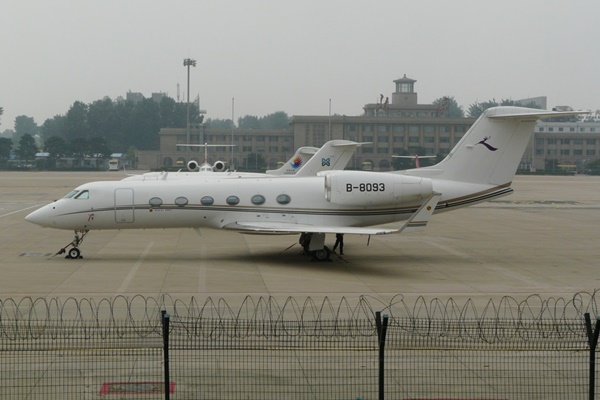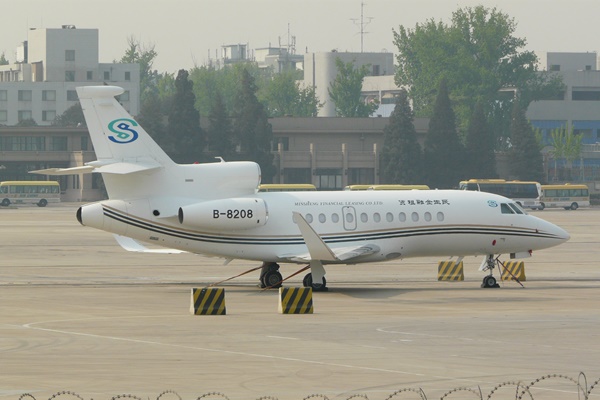Confidence in China’s business aviation growth shows signs of weakening

Confidence in China’s rapid business aviation growth is showing signs of weakening, as the country’s inherent issues show little sign of any short term fixes.

Just out of reach: DeerJet G450 B-8093 sits on the ramp at Beijing (Photo: Alud Davies).
The pace at which business aviation in China is growing is starting to be questioned, as the government’s tight control of its airspace shows little sign of loosening.
Although the country has been slowly experimenting with opening its airspace up, with small scale trials starting in Changchun and Guangzhou at the end of 2010, progress has been frustratingly slow, and is seen as one of the main barriers to the explosive growth rates predicted for the country.
ALSO SEE: China’s Catch 22: business jet operators struggle to profit
The Chinese Government identified general aviation as a focus sector in its 12th five-year-plan introduced in 2011, which suggests that by the end of 2015, the number of general aviation aircraft in China should double.
Off the back of this, the Civil Aviation Authority of China’s (CAAC) Air Traffic Management Bureau introduced a plan to loosen the air force’s tight grip on the country’s huge airspace.
Under the the CAAC plan, airspace under 1,000 meters is be classed as ‘Low Airspace’ and is split into split sections, with those sections classified as; areas under surveillance, areas under control, and areas where, after submitting a valid flight plan, users can fly freely.
Small scale testing took place in 2010 around Haikou, Hainan Island, after which the CAAC identified six further cities in central, north-eastern and southern China to take part in the extended testing in 2011, with the trials taking place around the airspace of Hangzhou, Kunming, Ningbo, Qingdao, Tangshan and Xi’an.
With successful completions of the trials, the roll out was due continue towards 2015 when the airspace between 1,000 and 4,000 meters will be tested, even around the Beijing area.
But since the initial trials took place the pace of reform has been painfully slow, and almost took a step backwards in 2013, when a Beijing-based technology company operated an aerial photography flight near Beijing’s Capital Airport without getting the proper authorisation.
With the flight operating in controlled airspace without prior agreement a number of flights landing at Capital Airport had to take evasive manoeuvres, causing further delays to an already heavily congested airport.
“Some people believe that our country’s reform of low-altitude airspace management means totally free navigation in low-altitude airspace. That is one-sided and incorrect,” said a Ministry of National Defense spokesperson on the agency’s website.

Minsheng Financial Leasing Falcon 900LX (Photo: Alud Davies)
China’s airspace woes are only one side of the story though, and while it remains a major barrier, the infrastructure – or lack of it – at major airports is also seen a major stumbling block.
Beijing, the country’s capital and by far the busiest destination for business aircraft, currently has one major airport, which is stretched to the brim with commercial flights, and consequently slots are limited for business aviation operations, with only one slot available per hour during busy times.
At present, Chinese airports are only allowed to have one fixed base operator (FBO) at each of the airports. In Beijing, where Capital Jet runs the airport’s FBO, the facility that Deer Jet built in time for the 2008 Olympic Games remains in use only as offices.
Although Deer Jet was allowed to operate from the new facility during Games, now that the event is over, their aircraft need to be towed to Capital Jet before they are allowed to fly.
Beijing does have a second airport; Nanyuan Airport sits in the south of the city between the fourth and fifth ring roads, but the airport is still under military control as an active air base for government flights. Commercial operations do take place, but are limited to China United Airlines, who were once the civil operations arm of the PLA until Shanghai Airlines took a 80 per cent stake in 2005.
Nanyuan, the oldest airport in China, is scheduled for closure before the decade is out, as Beijing’s new Daxing International Airport is scheduled for completion in October 2018.
Daxing, further south than Nanyuan, will not only serve as the main airport for Beijing, but also for Tianjin and Hebei.
Although plans are currently being drawn up for the airport, construction was given the go-ahead in January 2013 for an airport with seven runways – six for civilian use and one for military flights.
It is unclear if business aviation will be catered for at the new Daxing Airport, but by October 2018, the new Minsheng supported Sanhe, Hebei province airport could be a reality.
Sanhe, 60 km from central Beijing, is a joint venture between Minsheng, Sanhe Municipal Government and Hebei Province Aviation Investment Holdings and is billed as the country’s first general aviation airport.
Side-by-side with the airspace openings will also be a relaxing of flight plan restrictions – currently a major hassle for anybody wanting to fly into, out of, or within the country.
Up until 2009, when the CAAC relaxed the rules for Chinese registered business jets, it typically took between three to six days to get flight plan approval and would cost $4,000. Those rules have relaxed, and the fee waived, so it is now possible to file a flight plan up to six hours before departure. But for foreign, non Chinese aircraft, those restrictions are still in place.
Minsheng’s plans not only for Sanhe, but business aviation in China are fairly clear, with the company’s International Jet operating arm recently talking about its ambitious 100 aircraft plan.
ALSO SEE: Minsheng International Jet’s 100 aircraft plan
Minsheng Financial Leasing says it is not seeing signs of a slow down, with Zhu Limi, general manager – finance department, aircraft division, telling Corporate Jet Investor that her company took delivery of more aircraft in the first quarter of 2014 than the same period last year.
Minsheng’s positioning in China’s business aviation circles is a lofty one, with the company holding numerous outstanding orders with the majority of major business jet manufacturers.
The figures support Zhu’s comment, with data from US-based business aircraft market research company AMSTAT showing that while greater China took delivery of eight fewer aircraft in 2013 than 2012, 24 aircraft had been delivered to the region by the mid-point of the year.
While 24 aircraft might not seem like a huge amount of aircraft, in percentage terms the region accounted for 5.8 per cent of global deliveries in the first half of the year, up from 3.7 per cent for the whole of 2013.
Although the number of aircraft coming into the country is increasing, the number of aircraft up for sale in the country is also creeping up, and by the mid-point of the year, it hit a five-year high.
Data, again from AMSTAT, shows that the percentage of aircraft for sale in the country has jumped into double digits for the first time since 2009.
Ask any broker or aircraft valuer what the definition of a soft market is and they will immediately tell you that it is where 10 per cent – or more – of any aircraft type is listed for sale, so greater China’s 10.2 per cent inventory is another worrying sign.
Economically, the growth signs are still there. GDP growth remains impressive, with growth in the secound quarter of 2014 predicted to remain steady at 7.4 per cent, but perhaps a better sign of economic growth is that outbound foreign direct investment (FDI) is predicted to surpass inbound FDI in 2014 for the first time.
“We’re a business, not a lifestyle” David Dixon, president of Jetcraft Asia, said at the Corporate Jet Investor Hong Kong conference last month, when the issue of China’s perception of business jet use was discussed.
Dixon’s comment is right on the mark. Changing the attitude of China towards the real value of business aviation is proving to be hard work, with the general public still believing that business jets are simply play things for the rich.
And while there is undoubtedly an element of truth in that, the reasons behind those thoughts can be traced right back to where we started, with only the ultra rich able to afford to fly.
As Dixon later said, “the gold-rush isn’t over, its just been put on hold.”








